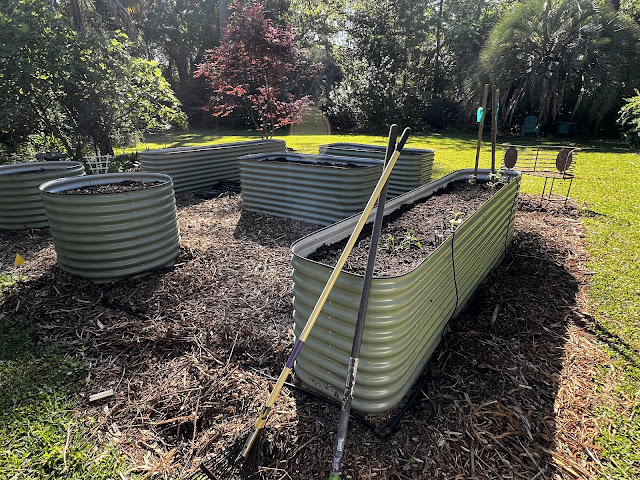When starting a garden in raised beds, a question always arises. How do we fill them? That isn’t too difficult when the beds are no more than 8 inches tall because you can fill them with garden mix, compost, or whatever you choose to grow plants in.
Taller beds can present a different problem. It takes a lot of compost or garden mix to fill a bed that’s up to 30 inches tall. Most plants only need six to eight inches of soil to grow quite well so other options are available to fill a tall bed. Adopting a method used in Hugelkultur beds as we did when the raised beds at the VegHeadz garden were installed is a good choice. This reduces the amount of expensive garden soil that you will need, provides benefits to the microorganisms and plants in the bed, and helps to dispose of yard waste that might otherwise go to a landfill.
Several installations of tall beds in private gardens recently illustrate how to fill garden beds with a variety of materials and provide an excellent growing medium for your plants.
These beds are pre-fabricated coated steel which are available at a local nursery or online. They can be purchased in a variety of heights and sizes and their cost is comparable to building beds of this size and height from other materials. They need no special tools for assembly and are warranted for 10 to 20 years, depending on the manufacturer.
 |
It’s always good to put
your family to work laying
out the garden … |
 |
and assembling beds
|
 |
Cardboard first, then rocks
|
The instructions that came with the beds suggested that rocks be laid first to provide better drainage, and to keep the bottom edges of the beds above the soil to prolong the life of the bed. In this instance, we went even further and put bricks under the corners of the beds to raise them off the ground. In the pictured garden, cardboard was placed on the soil throughout the garden including where the beds were to be placed to block any grass or weeds.
Once beds were assembled, placed and leveled, temporary cardboard barriers were placed around the outside of the beds to keep rocks in place as they were added to line the bottom of the beds. Free wood chip mulch several inches deep was added outside the beds and throughout the garden area. When all was in place, the temporary cardboard around the beds was removed. The mulch and rocks serve to hold each other in place at the bottom edge of the beds.
 |
Rock layer, with a cardboard and
mulch barrier holding them in
place under the bed
|
 |
Oak logs
|
Next, a layer of oak logs was laid. This can be any kind of organic debris, branches, leaves, etc. Following the logs we added a layer of wood chips to fill in the spaces around the logs. All these materials will eventually decompose into compost, and in the meantime, will retain moisture and provide nutrients to the microorganisms and plants that live in the bed. A small amount of heat is generated from decaying materials, possibly extending the growing season in the beds.
 |
Banana plants contain many
nutrients and break down easily.
They are excellent fill material.
|
The next layer was softer material available in this particular yard including pruning debris from winter damaged banana plants and large gingers. We were glad to have a place to dispose of these materials because they are voluminous, they don’t burn well, and adding them to the landfill is not an environmentally friendly option. Any kind of sticks, leaves, food waste (except meat and milk products like cheese), in fact, any organic materials can be used. Use what’s available.
We added a final layer of wood chips up to the level where we wanted to start adding garden soil, about eight or ten inches below the top of the beds.
 |
Final layer of wood chips
|
 |
| And finally garden soil |
For garden soil in this garden, we chose to use compost created without animal manure. This was purchased from a local non-profit compost producer. Non-manure compost was used because of a problem with excess copper in manure-based composts due to copper added to animal feeds. Excess copper can lead to reduced germination rates and damaged or dead seedlings.
Added to the compost was a mixture of amendments including slow-release organic fertilizer, azomite, kelp, and granite dust. A dusting of about half a pound of worm castings was added to each bed before the top inch or so of compost was added and the beds were complete and ready to plant. These materials can provide a boost to micronutrients and minerals which might be in low supply or absent in any particular compost or other growing medium. They are said to improve root growth, yield and taste of plants, and help ward off pest and diseases.
Space was left at the top to accommodate a layer of pine straw mulch around plants in the beds. The level of the soil in the bed will go down somewhat as the underlying materials decompose, and additional compost can be added at the top before each growing season as needed. In addition, decomposing mulch and cover crops, chopped and dropped, will add organic matter to the soil and help to maintain the bed level.














No comments:
Post a Comment